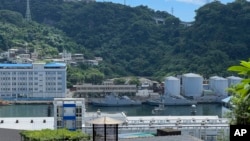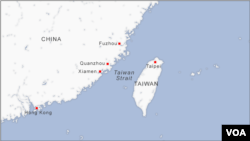Taiwan's defense ministry said it detected three more balloons from mainland China flying over the Taiwan Strait on Monday, the latest in a spate of such balloons the ministry has spotted over the past month.
The ministry said that since December it had detected nearly 20 Chinese high-altitude balloons crossing the central line of the Taiwan Strait, many of which flew over Taiwan, and that three in the past week had even passed over important military bases.
The ministry Saturday accused Beijing of threatening civil aviation safety and waging psychological warfare with the balloons ahead of the island’s presidential election on Saturday.
Asked Monday whether the balloons posed a threat to international civil aviation, China’s Ministry of Foreign Affairs spokesperson Mao Ning said to Reuters, "I'm not aware of the specifics you mentioned, and it's not related to China's foreign affairs."
Bid to tilt election?
Some experts believe China's balloons are part of Beijing’s attempts to influence the election.
Michael Mazza, a senior director at the Virginia-based nonprofit research group Project 2049 Institute, said the high-altitude balloons added to China’s military aircraft and warships around Taiwan.
"My hypothesis is that China is attempting to influence the elections,” he told VOA by email.
“Sending three balloons directly over Taiwan is a warning. China is saying that it is willing to blatantly violate Taiwan's borders,” Mazza added. “In doing so, it has crossed a threshold; further escalation could involve more threatening displays in Taiwan's skies. The message to Taiwan's people is this: Things can get even worse, but you can vote to make them better."
William Lai of the independence-leaning Democratic Progressive Party is the front-runner in the race, which includes Hou Yu-ih of the more Beijing-friendly Nationalist Party — also known as the Kuomintang or KMT, which is Taiwan’s main opposition party — and third-party candidate Ko Wen-je of the Taiwan People’s Party.
Brian Hart, a fellow with the China Power Project at the Washington-based Center for Strategic and International Studies, told VOA at an event on January 5 that over the course of a year, China has been using new types of activity, including heightened use of drones, to encircle the island.
"They're using various different tactics to threaten Taiwan and to put pressure on [ruling President Tsai Ing-wen's] administration,” he told VOA. “And so, I think we'll see that continue to varying extents. And I think, you know, potentially, if Lai wins the presidency, there's a considerable chance that Beijing ramps up that activity going forward."
China’s balloons grabbed international headlines in February when the U.S. shot one down after it entered U.S. airspace and flew across the country. Beijing denies it uses balloons for spying and says they are just weather balloons that have strayed from their flight paths.
Raymond Kuo, director of the RAND Corporation's Taiwan Policy Initiative, said that “the balloon overflights are in line with China's gray zone coercion strategy towards Taiwan.”
“The balloons travel at very high altitudes, making them difficult to shoot down,” he wrote in an email. “They are also relatively good intelligence-gathering platforms, able to move slowly over an area and possibly capture detailed information."
Challenge to sovereignty
To Beijing, said Kuo, the balloons prove that China can violate Taiwanese airspace at will and challenge its sovereignty, which demoralizes the Taiwanese population in the upcoming elections.
Kuo said he was doubtful, however, that China's tactic would be effective, as Taipei could use these incidents to push for closer security relations with the U.S. and other Asian partners.
"Chinese balloons have also crossed those countries' airspace, and a multinational response could bolster Taiwan's international profile and demonstrate to Beijing the costs of these incursions," he said.
Su Tzu-yun, a military expert at the Taipei-based Institute for National Defense and Security Research, said Taiwan has exercised caution so far, but could decide to shoot the balloons down.
“What the Taiwanese government is doing now is to be responsible for its territory as what international law mandates,” he said. “Additionally, it demonstrates to Taiwanese citizens that the government can detect this type of threat and identify the level of risks that the balloons pose to Taiwan.”
Su also said Taipei’s restraint was a display of measured threat detection.
“Taiwan is demonstrating the art of determining the proper level of response to threats,” he said. “This doesn’t mean Taiwan has no bottom line. When the balloons start to pose a threat to Taiwan, authorities need to adopt resolute measures to shoot down the balloons.”
China’s one-party state has claimed self-governing Taiwan as part of its territory since China’s civil war ended in 1949 with the defeated nationalists fleeing to the island.
The United States has since 1979 upheld a “One China” policy that officially severed diplomatic ties with Taipei and recognized the government in Beijing — but also a Taiwan Relations Act that backs Taiwan’s right to self-rule.
In a news briefing on January 4, U.S. National Security Council spokesperson John Kirby reiterated Washington’s support for the democracy and democratic institutions of Taiwan and urged anyone outside Taiwan not to interfere in Taiwan's ability to have a free and fair, democratic election.
Adrianna Zhang and William Yang contributed to this report.









